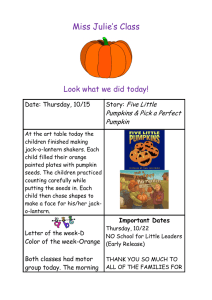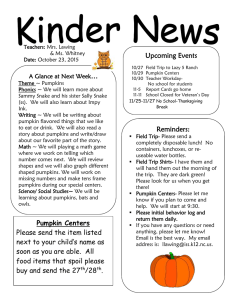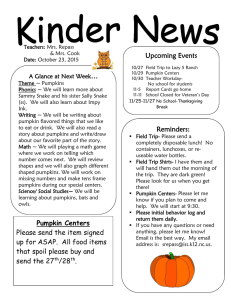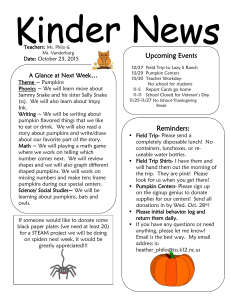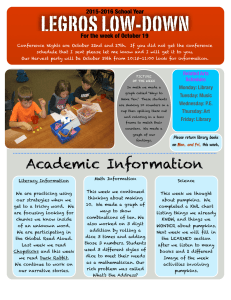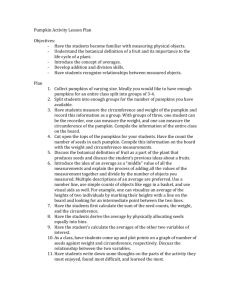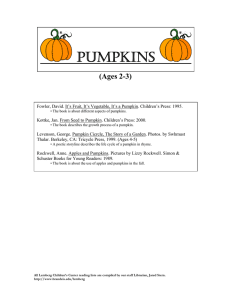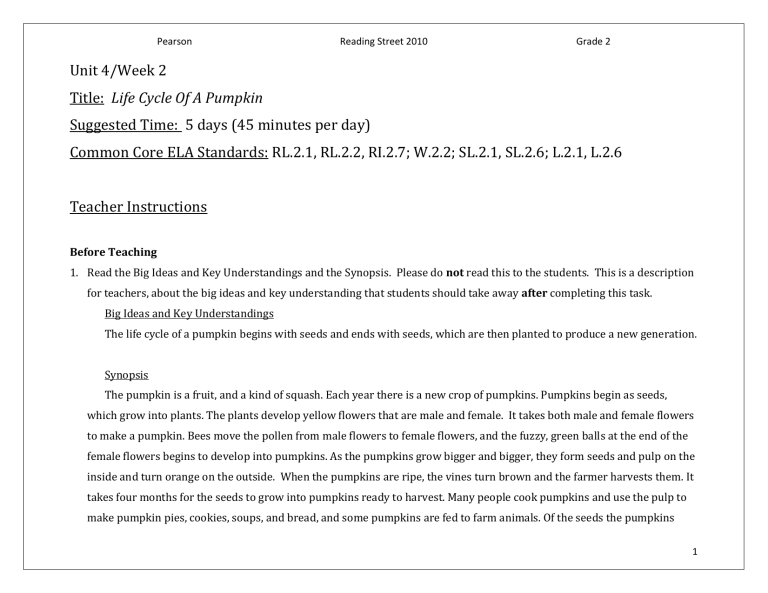
Pearson Reading Street 2010 Grade 2 Unit 4/Week 2 Title: Life Cycle Of A Pumpkin Suggested Time: 5 days (45 minutes per day) Common Core ELA Standards: RL.2.1, RL.2.2, RI.2.7; W.2.2; SL.2.1, SL.2.6; L.2.1, L.2.6 Teacher Instructions Before Teaching 1. Read the Big Ideas and Key Understandings and the Synopsis. Please do not read this to the students. This is a description for teachers, about the big ideas and key understanding that students should take away after completing this task. Big Ideas and Key Understandings The life cycle of a pumpkin begins with seeds and ends with seeds, which are then planted to produce a new generation. Synopsis The pumpkin is a fruit, and a kind of squash. Each year there is a new crop of pumpkins. Pumpkins begin as seeds, which grow into plants. The plants develop yellow flowers that are male and female. It takes both male and female flowers to make a pumpkin. Bees move the pollen from male flowers to female flowers, and the fuzzy, green balls at the end of the female flowers begins to develop into pumpkins. As the pumpkins grow bigger and bigger, they form seeds and pulp on the inside and turn orange on the outside. When the pumpkins are ripe, the vines turn brown and the farmer harvests them. It takes four months for the seeds to grow into pumpkins ready to harvest. Many people cook pumpkins and use the pulp to make pumpkin pies, cookies, soups, and bread, and some pumpkins are fed to farm animals. Of the seeds the pumpkins 1 Pearson Reading Street 2010 Grade 2 produce, some are roasted and eaten as snacks, while others are saved to be planted in the spring. They will grow into next year’s pumpkins. 2. Read entire main selection text, keeping in mind the Big Ideas and Key Understandings. 3. Re-read the main selection text while noting the stopping points for the Text Dependent Questions and teaching Vocabulary*. During Teaching 1. Students read the entire main selection text independently. 2. Teacher reads the main selection text aloud with students following along. (Depending on how complex the text is and the amount of support needed by students, the teacher may choose to reverse the order of steps 1 and 2.) 3. Students and teacher re-read the text while stopping to respond to and discuss the questions and return to the text. A variety of methods can be used to structure the reading and discussion (i.e.: whole class discussion, think-pair-share, independent written response, group work, etc.) Text Dependent Questions Text-dependent Questions Page 64 According to the text, what are the characteristics of pumpkins? Page 65 How do new pumpkins begin? Evidence-based Answers The text on page 64 says that pumpkins can be bumpy or smooth, large or small, long or round, orange, white, yellow, or red. They are also fruits, and they grow on a vine. Pumpkins begin as white, oval seeds. There is a tiny plant curled up inside each seed. Page 65 What happens after a pumpkin seed is planted? According to the text on page 65, in about ten days a root grows down into the soil. Tiny leaves push up into the sunlight. 2 Pearson Reading Street 2010 Page 65 What does the root supply to the plant? Page 66 What do the leaves supply to the plant? Page 67 Using the information in the text and illustration on page 67, what is a tendril? Page 67 How does the pumpkin plant grow? Page 68 What are the characteristics of male flowers? Page 69 What do bees supply to the plant? Page 69 What happens to the female flowers after bees bring pollen to them? Page 71 What do pumpkin plants need to grow well? Grade 2 The root supplies water and food for the plant. The leaves use sunlight and air to supply food for the plant. The text says that a tendril is thin, and that it grabs and curls around other vines. The illustration shows a green, curly stem. Tendrils support vines as they grow. First it grows more leaves. Next, it becomes a vine. The vine grows along the ground. It sends out tendrils that grab and curl around other vines and fences. Male flowers have long stems. They have yellow pollen inside the flowers. Bees move pollen from male flowers to female flowers. The pollen sticks to its body and legs, and rubs off onto flowers. After bees bring pollen to the female flowers, the fuzzy, green ball at the end of the flower begins to grow into a pumpkin. Page 72 When do farmers harvest pumpkins? Pumpkin plants need just the right amount of water and sun to grow well. They need to be protected from too much rain, sun, and insects. Farmers harvest pumpkins when the vines turn brown. Inside the pumpkins are seeds and pulp. Page 73 What do people produce with pumpkins? According to the text, people cook pumpkins and make pie, cookies, soup, and bread from the pulp. Pages 74-75 What happens to the seeds that pumpkins produce? Some seeds will be roasted for snacks. Other seeds are saved and planted in the spring. They will grow into next year’s pumpkins. 3 Pearson Reading Street 2010 Grade 2 Vocabulary STUDENTS FIGURE OUT THE MEANING sufficient context clues are provided in the text TEACHER PROVIDES DEFINITION not enough contextual clues provided in the text KEY WORDS ESSENTIAL TO UNDERSTANDING Page 71 - protect Page 72 – harvest Page 64 – crop Page 68 – stem Page 68 – bloom Page 70 – all (all summer) Page 72 – pulp Page 75 – plow (verb) Page 75 - unpicked WORDS WORTH KNOWING General teaching suggestions are provided in the introduction Page 64 – fruit (fruits have seeds) Page 64 – vine Page 67 – tendril Page 70 – underneath Page 71 – wither Page 71 – insecticide Page 72 – form Page 74 - roasted Page 65 – oval Page 65 – moist Page 66 – jagged Page 66 - prickly 4 Pearson Reading Street 2010 Grade 2 Culminating Task Re-Read, Think, Discuss, Write Using information from the text and illustrations, complete the Life Cycle/Flow Chart Graphic Organizer ( the five steps students will write about. @Loving2learn.com ) to show Writing Task Write about the five steps in the life cycle of a pumpkin. Name the text and use evidence from the text to explain the five steps, and include at least two page numbers that show where you found evidence. Answer (responses may vary) The book, Life Cycle Of A Pumpkin, describes five steps in the life cycle of pumpkins. First, pumpkins begin as seeds. After the seeds are planted, roots and two seed leaves grow. The seed leaves use sunlight and air to make food for the new plant. (Page 66) Then the plant grows into a vine and produces flowers. Female flowers get pollen from bees. After that, the fuzzy, green balls at the end of the flowers develop into pumpkins. (Page 69) After four months, the pumpkins are big and orange, and farmers harvest them. They have seeds and pulp inside. Some of the seeds get eaten, but farmers plant the other seeds. Those seeds grow into next year’s pumpkins. Notes to Teacher: Additional academic vocabulary to teach: characteristics, produce, supply 5 Pearson Reading Street 2010 Grade 2 6
